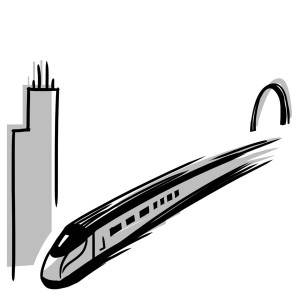Staff Columnists
High speed rail is the future of infrastructure
Recently, additional federal funding was provided to advance the high-speed corridor being built between Chicago and St. Louis to be finished by 2014. This increase, which amounts to about $186 million, would allow for a 110 miles-per-hour rail passage along most of the distance between the two cities. This is a remarkable step forward toward improving the transportation infrastructure in the Midwest that could provide both more efficient and less expensive alternatives to air and car travel. High-speed rail travel does not have a very large history in the United States; currently only one passage exists and although it can reach a maximum of 150 mph, due to the use of conventional tracks, it only averages about 68 mph. Nonetheless, high-speed rails are critical to the future of American transportation infrastructure.
Around 50 years ago former President Dwight D. Eisenhower approved the Federal Aid Highway Aid Act of 1956, which provided for the construction of the Interstate Highways. That system revolutionized American transportation infrastructure, providing for easy, affordable and efficient cross-national transportation for anybody with a car. Two generations later, with the prices of air travel and gasoline inching upwards, traveling around the country is becoming somewhat more difficult. A high-speed rail revolution could make intranational transportation far more affordable and easy, and provide substantial economic benefits for the nation and its citizens in both the short and long-term, similar to that of the interstate highways.
It is plainly visible to those who travel that our infrastructure is not only outdated, but also crumbling, exemplified by the 2007 collapse of the I-35W bridge across the Mississippi River in Minneapolis. Certainly such problems with our national roads need to be remedied, but in addition, rail lines can be constructed in order to remove some of the stress on certain congested roads. Moreover, the climate effects from millions of cars, many used to inefficiently transport small groups of individuals, can be counteracted by the use of high-speed trains that can transport large numbers of people across the country far more quickly and economically than cars on the highway.
For experience, we can observe the effects of high-speed transportation in other nations such as Japan, South Korea, much of the European Union and even China, where millions of passengers are transported each year between large metropolitan areas. In such areas, the rail systems have undercut the necessity for air and car travel in hugely congested areas, providing a safer and cleaner living environment. Such systems are also especially efficient once they are linked into local transportation infrastructure.
Imagine a weekend in St. Louis, perhaps at Washington University, in which you decide you want to travel to Chicago. Currently, you have a few options: You could take a bus, a plane or a car. The bus and the car are both very time-consuming and the plane can be rather expensive, not to mention the hassle of dealing with airport and airline regulations about luggage size, etc. In 2014, you could opt to take the new high-speed rail line and save both money and time.

